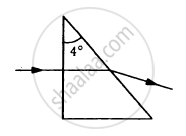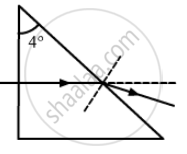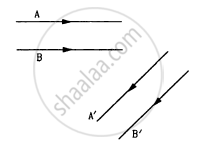Advertisements
Advertisements
Question
Find the angle of deviation suffered by the light ray shown in figure. The refractive index μ = 1.5 for the prism material.

Solution
Given,
The refractive index of the prism material (μ) = 1.5
Angle of prism form the figure = 4˚
We know that,
\[\mu = \frac{\sin\left( \frac{A + \delta_m}{2} \right)}{\sin \frac{A}{2}}\]
\[ \mu = \frac{\left( \frac{A + \delta_m}{2} \right)}{\frac{A}{2}} \left( \text{ because for small angle } \sin \theta \approx \theta \right)\]
\[ = \frac{A + \delta_m}{2^\circ }\]
\[1 . 5 = \frac{4^\circ + \delta_m}{2^\circ}\]
\[ \delta_m = 2^\circ \]
Hence, the angle of deviation is 2˚
APPEARS IN
RELATED QUESTIONS
Use the mirror equation to show that an object placed between f and 2f of a concave mirror produces a real image beyond 2f.
Use the mirror equation to show that an object placed between f and 2f of a concave mirror forms an image beyond 2f.
Define the term 'limit of resolution'?
Use the mirror equation to show a convex mirror always produces a virtual image independent of the location of the object ?
following Figure shows two rays A and B being reflected by a mirror and going as A' and B'. The mirror
Which of the following (referred to a spherical mirror) do (does) not depend on whether the rays are paraxial or not?
(a) Pole
(b) Focus
(c) Radius of curvature
(d) Principal axis
A light ray falling at an angle of 45° with the surface of a clean slab of ice of thickness 1.00 m is refracted into it at an angle of 30°. Calculate the time taken by the light rays to cross the slab. Speed of light in vacuum = 3 × 108 m s−1.
A small object is placed at the centre of the bottom of a cylindrical vessel of radius 3 cm and height 4 cm filled completely with water. Consider the ray leaving the vessel through a corner. Suppose this ray and the ray along the axis of the vessel are used to trace the image. Find the apparent depth of the image and the ratio of real depth to the apparent depth under the assumptions taken. Refractive index of water = 1.33.
A light ray is incident at an angle of 45° with the normal to a √2 cm thick plate (μ = 2.0). Find the shift in the path of the light as it emerges out from the plate.
A light ray, going through a prism with the angle of prism 60°, is found to deviate by 30°. What limit on the refractive index can be put from these data?
Name the physical principle on which the working of optical fibers is based.
A parallel beam of light is allowed to fall on a transparent spherical globe of diameter 30cm and refractive index 1.5. The distance from the centre of the globe at which the beam of light can converge is ______ mm.
The focal length f is related to the radius of curvature r of the spherical convex mirror by ______.
An upright object is placed at a distance of 40 cm in front of a convergent lens of a focal length of 20 cm. A convergent mirror of focal length 10 cm is placed at a distance of 60 cm on the other side of the lens. The position and size of the final image will be ______.
A point object is placed at a distance of 30 cm from a convex mirror of a focal length of 30 cm. What is the separation between the image and the object?
A convex lens of focal length 15 cm is placed coaxially in front of a convex mirror. The lens is 5 cm from the pole of the mirror. When an object is placed on the axis at a distance of 20 cm from the lens, it is found that the image coincides with the object. Calculate the radius of curvature of the mirror - (consider all-optical event):
